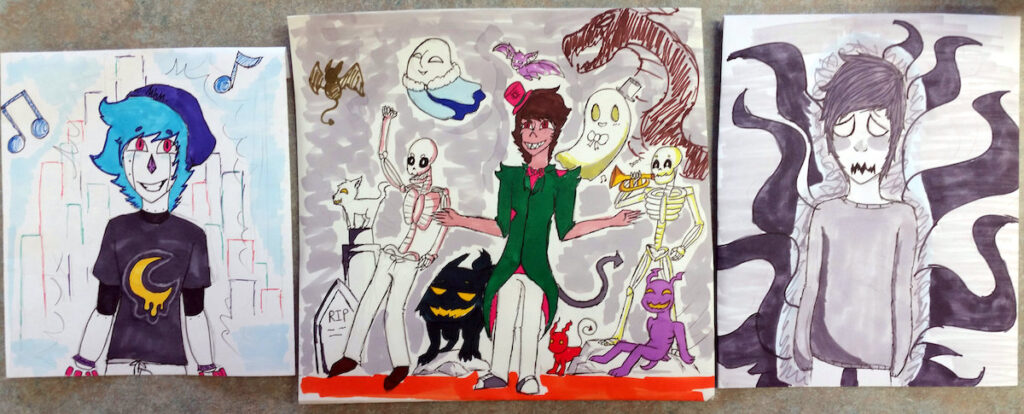I look forward to final exams each year. I’m not crazy (really!) I just have an exam that is perfect for my program. My kids love it, too, and tend to be much more engaged in the final weeks leading up to exam day. It’s project-based, student-directed, and requires kids to apply the skills they’ve worked the whole course to develop.
The task I give my high school students is this: Design a collection of work around a central theme or goal and share it with the entire school in a pop-up gallery show during the last week of school.

If you would like to try something similar, here are the steps to take.
1. Select a Theme or Set a Goal
Themes
Designing the portfolio starts with selecting a theme or goal. Themes should be topics the student is interested in and ideas that can be explored through multiple works. Since generic themes can lend themselves to trite work, helping kids narrow down broad themes into specific statements or questions is extremely helpful. I never say I don’t like a theme because I want to value the thought the student has put into selecting it. Instead, I ask questions to help narrow the focus.
I might ask things like:
- Can you make a sentence out of the word you selected as your theme? Can you make it a question?
- What do you want people to know about your theme from looking at your artwork?
- Can you make a list of words you associate with this theme?
- What do you want to say about this topic?
- What’s your point of view?
Here are a few examples of broad themes narrowed down:
Broad: Nature
Narrower: The Beauty of the Cape Hatteras Seashore
Broad: Love
Narrower: Depicting the Meaning of Important Relationships in My Life
Broad: Body Image
Narrower: How Teen Girls Are Depicted in the Media vs. What they Really Look Like

Goals
Goals, on the other hand, are more about what students want to improve on or explore. They are concrete, which makes them a good choice for students who feel overwhelmed by the idea of selecting a theme. Goals can be based on a specific medium or technique or can be more general.
Here are a few examples:
Medium/Technique Goal: Learn how to create portraits by dripping watercolor.
More General Goal: Improve realistic drawing ability.
No matter which type of goal a student sets, they should start their portfolio by completing a pre-assessment. Creating work related to their goal before learning anything new creates a record of their skill level which can be compared to later work to assess growth.
2. Create the Work
Once students have selected a theme or goal it’s up to them to plan, design, and create their original work. This might seem like a lot to ask kids to do, but they are ready to handle the challenge because I’ve spent the entire course up to this point teaching them how to make these sort of decisions with a framework I call the Artistic Thinking Process.
If you’d like to learn more about what this looks like, these links provide in-depth information:
- Teaching Skills for the 21st Century: Creativity
- Independence! via my blog, Thoughts on Arting
- Motivation via my blog, Thoughts on Arting
As students make decisions about media, processes, and how to polish ideas into finished work, I help them navigate through the decision-making process by being an extra pair of eyes and ears. I conference with students daily, giving them feedback, asking questions, and cheering them on as they build cohesive collections or make daily progress toward the goal they’ve selected.

3. The Big Day
As our pop-up art show day nears, both the pressure and the excitement build. There’s nothing like the urge to look good in front of peers to motivate students to do their best. On the big day, we set up work on tables in a public area, along with artist statements and snacks to lure a good audience. As high schoolers and teachers mingle and look at the amazing things each artist has accomplished, my students beam with pride. “This,” I tell them afterward, “is what it feels like to be an artist.”

This final exam is deeply satisfying for everyone involved. Students love it because they are given the freedom to make meaningful art. The school community enjoys it because they are able to see the work alongside the students who made it, all without attending an after school event. As for me, I’ve given a number of exams over the years and they always felt artificial and disconnected from anything of real importance. This exam is anything but. It’s relevant, personalized, and requires a deep application of learning, which makes it, for me, the ultimate final exam. I can’t imagine ending the year any other way!
Do you have an amazing final exam? Tell us about it in the comments section.
Magazine articles and podcasts are opinions of professional education contributors and do not necessarily represent the position of the Art of Education University (AOEU) or its academic offerings. Contributors use terms in the way they are most often talked about in the scope of their educational experiences.




